|
| Outline of the Program |
 |
A Bridge to Society through 3-Phase gKototsukuri (Creative Actions)h
- From Problem Solution Type Support to Growth Promotion Type Support -
@@@@@ |
 |
Program Manager: Director, Vice President (Education)
General Director of Student Support Center Akio Saito
|
1. Background and Purpose of the Program
@One of the tendencies seen in counseling activities for students in recent years is that many students showing weakening of self-expression ability and lack of mutual support, symptoms of isolation from the surroundings, getting caught in unexpected troubles, and experiencing depression (psychological powerlessness), so that counselors cannot catch up with the demand of consultation needs despite beefing up of the staff. Therefore, there is a need for contriving and planning not only the gproblem solution type student supporth where gmeasures are taken when students have come to ask for helph but also the ggrowth promotion type student supporth where the university is to propose gproactive program.h The most frequent problem we are faced with is the studentsf ghuman relationh and its severity is such that it almost made us be concerned about the possibility of the students of Tokyo Tech may be having little or no ability of playing sociable and cooperative with others, so that it has required us to try plans to develop students with gmore sociabilityh and ginitiativesh toward the goal of gnurturing creative persons who can show global leadership.h In order to have a break through in such a condition, we are proposing a plan for building a bridge to society through 3-phase gKototsukuri (Creative Actions)h concept where a multiple layers of support works together jointly in different formats.
2-1. First Phase of gKototsukuri (Creative Actions)h: gEventsh
@The essence of the first phase is to create a lot of events in student lives and increase the chance of collaborations between students. In order to materialize such a state, set up an organization named "Student Think Tankh erected on the three pillars of campus guide, public relations support, and peer support which are already in action, create various needs in and out of the university, and develop it as a movement backed by student power.
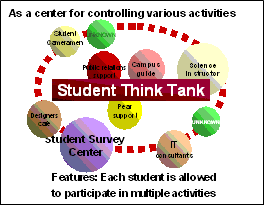 |
Fig. 1 As a center for controlling various activities
|
@At the moment, various activities are in their development stages; for example, gscience instructorsh visit local grade schools or have events for middle school and high school students to serve as preachers to show the funs of science to them through experiments and Kototsukuri (Creative Actions). In the "Student Survey" program, a survey of the entire students by means of a website has been conducted (first trial implemented in 2004 and has been conducted every other year since 2005), the result of which is analyzed by students themselves, and a cycle has been established consequently, in which a proposal is compiled by students based on the survey result analysis and the instructors of all offices endeavor to improve the teaching system according to the proposal. While all of these activities are designed to use the studentsf knowledge and techniques, it is still undeniable that the activities are still gsmall in size,h gstill relying on the teaching staff,h and gsporadic.h Therefore, gStudent Think Tankh is invented to serve as a center for controlling various activities and also to allow each student to be able to participate in multiple activities through it (Fig. 1).
@Although Student Think Tank shall eventually be operated by students, teaching stafffs support is essential in the startup time, or whenever it is necessary, so that it can properly accomplish the purposes of gvitalization of current status,h gbuilding a bridge to society,h and gcreating a new plan.h Hence, GP teaching staff and administrative staff have been chosen and are already working actively. Moreover, "Electronic Bulletin Board System" has been implemented so that necessary information can be shared in real time throughout the campus, so that it is expected that spontaneous changes of gKototsukuri (Creative Actions)h will be possible as needed. It is used to siphon up studentsf opinions and requests for the time being, but a new project "Game Contest" is being established to promote more active exchanges with other universities.
2-2. Second Phase of gKototsukuri (Creative Actions)h: gWordsh
@A person learns a way to overcome incongruity he faces in life by talking to others using words to clarify differences that exist between himself and others and defining the idea as sentences. For a science or engineering student, the acquisition of communication and writing capability is not only indispensable for forming personality but also is an extremely important task to be able to communicate the scientific and technological world to laypersons. Therefore, in the second phase, we aim to nurture students capable of communicating their thoughts and feelings with their own words without being confined to their narrow worlds and value concepts by expanding the two activities of gcolumnlandh and gscience cafe further as gwriting communities.h
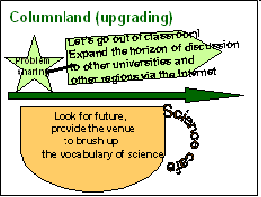 |
Fig. 2 Advanced form of Columnland & Science Cafe
|
@gColumnlandh has been involved in developing studentsf personalities through a process in which students first receive instructions through lectures, submit their works to the column under anonymity (self-expression), discuss each otherfs works (understanding others), and select winning works (competition). This program has been highly acclaimed by students as is verified by the chronological improvement of their works and their comments after the program is completed. We are currently preparing an upgrading of this program to publicize the works on the Internet in order to broaden the range of interactions not only throughout the university but also to the outside world, and already collaboration among outside people who have strong desires for participation, student commentators who have intensive desire to speak, and graduate students taking the course is occurring, while confirming the difference in value concepts, exchanging views, and agreeing on many issues (Fig. 2).
@Science cafe is an event in which professionals and citizens talk to each other mainly on science and engineering issues and has been conducted primarily by graduate students. While an enormous effort is required in selection of topics (e.g., battery = energy issue, gravity = PET bottle rockets, etc.), creating a proper discussion mood of the day, presentation of information, and a technique of being a conductor of conversations, students can learn a lot from the effort of speaking and listening, embarrassment of facing different value concepts, etc. With a concept of gLet us be a researcher who can create science cafe," a seminar targeting undergraduate students with a title of gLanguage, Culture and Information Seriesh is implemented to let them think what kind of thoughts and skills are needed in order to ghave a dialogueh beyond the simple issue of expression. Tokyo Tech Science Cafe of this year will be expanded to include the participation of undergraduate students, so that a more lively collaboration between undergraduates and graduates is expected to happen fueled by colorful ideas of undergraduates.
2-3. Third Phase of gKototsukuri (Creative Actions)h: gDifferenceh
@Over 1000 international students primarily from Asian countries study at Tokyo Tech, and they constitute approximately 10% of the entire student body. It is our urgent task to support those international students whose number is expected to increase further in the future on their needs in life and studies, as well as to vitalize their interactions with Japanese students. Consequently, we decided to establish International Students Association (TISA) to prompt exchange and mutual interactions beyond the boundaries of international student bodies which have existed by nationality.
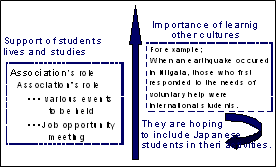 |
Fig. 3 Development of Support by Establishing TISA
|
@In the third phase, our aim is not only to support international students who are struggling bravely in a foreign country but also to change the awareness of Japanese students by creating a campus where a rich multi-culture environment exist by having various events to promote friendship and understanding of different cultures. The Association is ready to be established within the current academic year, and various exchanges including Sports Festival are already being planned (Fig. 3).
3. Effectiveness of New Initiative - Its Future
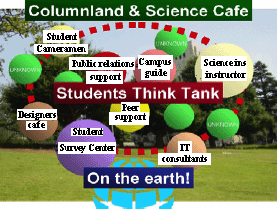 |
Fig. 4 Kototsukuri (Creative Actions) Movement
|
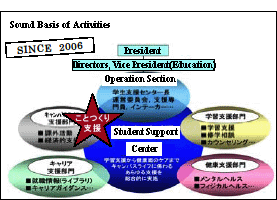 |
Fig. 5 Student Support Center
|
@@The entire image of the gKototsukuri (Creative Actions)h movement can be summarized in a conceptual diagram comprising three elements described above, i.e., the Think Tank where actions grow as fruits (phase 1), bristling leaves of words that nurture the power of communication (phase 2), and water veins supplied by different cultures (phase 3). By positioning all three elements structurally makes the student support activities more fruitful strategically and efficiently (Fig. 4).
@By promoting various gGrowth Support Typeh activities, students will gain power to be able to confront their own problems, as well as to support each other. It also provides venues and activities where they can visit for consultations and explain their needs and problems with their own words, to seek quick solutions or regain strength and confidence. It also provides a feedback effect for the gProblem Solution Typeh support that opens a gate for a wider range of students as gstudent consultation and support as a part of education.h
@Moreover, the gStudent Support Centerh (Fig. 5) is being established as the basis of all the abovementioned activities, where, under the "Operation Section" headed by the Vice President (Education), the counselor of gStudy Support Section,h the doctor of gHealth Support Section," the career adviser of "Career Support Section," and the coordinator of this program who belongs to the "Campus Life Support Section,h as well as all the professional teaching staff members who are assigned to the abovementioned four sections solidly support the system. Also, the gGood Student Support Practice Officeh is prepared for the President to render his directions when needed to guaranty that all events are conducted under the campus-wide consensus.
@Furthermore, by adding the Student Symposium for assuring communications between these three phases, the "Student Support Power" improvement plan intended for teaching staff members, and projects such as site surveys of domestic and overseas advanced schools as well as exchange programs with them, the gstudent support system established on four pillarsh of this university, which can be summarized in four words, gadvanced, bilateral, international, and integral,h will be advanced further. During the four year period estimated as the implementation period, we will check the evaluations of the students through gStudent Surveyh as well as evaluations of the grade schools, local communities and industries who are accepting student activities, and feedback the result to the program. We intend to find a new "form of student support" that results from synergistic actions of various activities and we will report our findings to all those who are interested of the entire nation.
|
|
| |
|
|
* The above description is identical to the material distributed at "2007 University Education Reform Program" held on February 9, 2008 under the sponsorship of Ministry of Education and Bunkyou Kyoukai.
|
|

